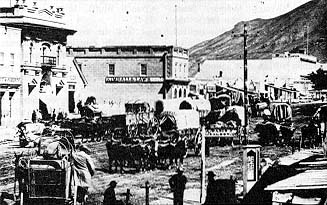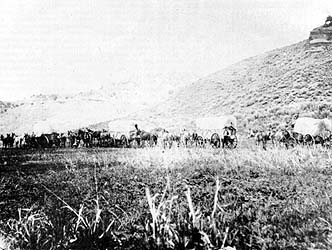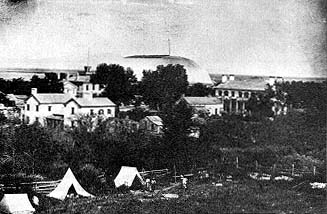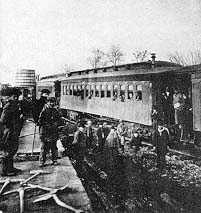“Westward the Saints: The Nineteenth-Century Mormon Migration,” Ensign, Jan. 1980, 7
Westward the Saints:
The Nineteenth-Century Mormon Migration
Authors’ original spelling has been retained, following standard historical practice. See reasons for spelling variations in “Nineteenth-Century Spelling,” Ensign, Aug. 1975—including uncertain spelling conventions and spelling as an expression of personality.
The April sun at daybreak cast long, lonesome shadows across William Grant’s hometown village, Willenhall, Staffordshire, in England. A 28-year-old convert of sixteen years, he clutched the cornet that had won him prominence in the brass band, checked his pockets for hard-earned savings, and turned toward Liverpool and the ship that would take him, his wife, and their three children to Zion.
“I took one long look Back, … Thousands of Circumstances Crowding my mind of things in the past,” he wrote, “but they were soon forgotton in thoughts for the great future. Some 9000 Miles of Travel was here before us.”
William would live out his life in American Fork, Utah, a bandleader, choirmaster, music store owner, and part-time farmer. When he arrived in 1866, he owned only the belongings he had packed into a small cart in Willenhall. “Economy was the motto,” he remembered. “We denied Ourselves all Luxury and barely took the Necessaries of life.”1 They had not even been able to afford cooking utensils for the ocean voyage. Like thousands and tens of thousands of Latter-day Saints who repeated the process between 1840 and the end of the century, William Grant sacrificed property, friends, family, and familiar surroundings because of his faith in the principle of the gathering.
William Grant, who lived a quiet, unpretentious life, had nevertheless participated in a heroic event. He and others of the pioneering generation have been remembered and honored by succeeding generations as examples of inspiring faith and perseverance. Twenty-fourth of July parades, Promised Valley pageants, pioneer societies and museums, statues, trail markers, and other commemorations properly celebrate the drama of the crossing and, to some extent, romanticize these events.
Part of this overstatement is regrettable; sometimes we lose sight of human dimensions through the mists of grandeur. But the fact remains that participants in Latter-day Saint migrations emerged from the experience tried and tested as a people. Nothing can detract from the sheer fact of their achievement—the numbers involved, the organization required, and the dedicated effort it took.
Thousands Came
No one knows exactly how many Latter-day Saints migrated during the half-century that the gathering was encouraged by Church leaders. But at least 85,000 members, perhaps half again that many if children and independent immigrants are counted, sailed from Liverpool during that time. Another twenty thousand headed for Utah from American towns and cities.2
The international movement began from England in 1840, and twelve years later from Scandinavia. By the 1860s the United Kingdom still supplied around sixty percent of all those leaving Europe, but decreased to less than half as other nations began sending more. Scandinavia, with relatively few converts, still accounted for about a third of the total Mormon migration.
Model Organization
Historians of the American West have called the Latter-day Saint migration one of history’s best-organized mass movements, a model of discipline, organization, orderliness, and cooperation.3 Setting the pattern for migration was the revelation given through Brigham Young near Council Bluffs, Iowa, in January 1847:
“Let the companies be organized with captains of hundreds, captains of fifties, and captains of tens, with a president and his two counselors at their head, under the direction of the Twelve Apostles.
“And this shall be our covenant—that we will walk in all the ordinances of the Lord.” (D&C 136:3–4.)
Jane Rio Pearce captured the essence of the schedule aboard a Latter-day Saint immigrant ship in 1851:
“A bugle sounds every morning to let us know it is 6 o’clock, when all who think proper, arise. At 7:30 it sounds again for morning prayer, after which, breakfast. We then make beds, etc. We employ ourselves during the day according to our inclinations. Sometimes a few musical ones get together and have a few tunes. Sometimes get together and gossip and so the day passes. When we have rough weather we have enough to do to keep on our feet and laugh at those who are not so clever as ourselves! But we are most of us getting our sea legs as the sailors say.”4
Members on each ship (and later in wagon companies) were organized into wards or branches; a missionary returning home was often the presiding officer. Regular religious services were held, and prayers in each ward at nine concluded the day.
The shepherding influence of the Church organization during the wearying journey accomplished two purposes: it gave the uneasy traveler a feeling of security and trained him to be obedient to his leaders. Bishops and branch presidents counseled the uncertain and encouraged the homesick or seasick. They performed marriages and buried the dead; before childbirth they pronounced blessings on the mothers-to-be. Jane Pearce, for one, found her shipboard branch president “a really sincere servant of God. His name is William Gibson, a native of Bonny Scotland, and his office is to watch over us as a pastor, to counsel, exert, reprove if necessary. In short to see that all our doings are in accordance with our profession as Saints of the Most High God.”5
Sometimes the organization was even more detailed. Even on the plains, handcart pioneer Henry J. Harrison reported a Sunday afternoon visit from his home teacher who “came around to Know how Your standing was in the Church.” During an 1862 ocean voyage, William Wood was assigned by branch president Francis M. Lyman to look after the temporal needs of four women, two of whom were traveling with children, and an elderly man. This traveling home teacher commented,
“It was remarkable how quick the people settled down to the requirements of those who were selected as bishops over the respective wards. I do not think the same number of people being non-Mormons would have settled down to such order. Nothing but the Spirit of the Lord would produce such harmony.”6

Ox carts in Salt Lake City in the 1860s. (From the Charles William Carter Glass Negative Collection, Church Library Archives.)
Unity through Faith
Order established among these Latter-day Saints from all walks of life and every economic circumstance was one of the achievements of the migration. Another was the unity of their common motivation. The migration was a physical act expressing and confirming faith. To “gather out of Babylon” meant to the nineteenth century Latter-day Saint both a spiritual separation from worldliness (a meaning that has survived to our day) and a geographical refuge in Zion, a central gathering place.
We see this process beginning as early as 1831 when the Colesville Branch, for one, migrated en masse from western New York, first to Ohio and then to Missouri. Other members joined them in building new Latter-day Saint communities. Driven from those temporary harbors, the Saints of the late 1830s sought a new home in western Illinois. To Nauvoo came the first European emigrants in 1840. Then, in 1846 began the famous evacuation and trek across Iowa to Winter Quarters, Kanesville, and other staging grounds that became the launching points for Utah.
Thus, in some sense, the Church had always been an organization on the move. And those pre-1846 migrations built the leaders who made the exodus to the West successful. Zion’s Camp, led by Joseph Smith from Kirtland to Missouri in 1834, had tested several faithful elders who gave important spiritual and temporal leadership on the westward trek: Brigham Young, Heber C. Kimball, Orson Pratt, Wilford Woodruff, Parley P. Pratt, Orson Hyde, and George A. Smith. A few years later Brigham Young, as a senior member of the Twelve, had helped direct the sorrowful winter march out of Far West and northern Missouri. He had been determined then that poverty would not force a sincere Saint to stay behind, and that same determination flowered in the 1850s into the Perpetual Emigrating Fund.
Perpetual Emigrating Fund
The Perpetual Emigrating Fund was a hand stretched out to those without sufficient resources to pay their passage. The needy Saints borrowed from the PEF with a promise to repay as soon as possible after reaching Salt Lake City. A revolving fund, its success was based upon the constant flow of the funds available to it. It began in 1849 and received periodic transfusions with money contributed by Saints in both Europe and the States. These additional contributions were essential, for gradually over the years the unpaid debt to the fund increased, until by 1880 the debt plus interest had reached $1.6 million.
During that year of jubilee, the Church’s fiftieth anniversary, President John Taylor announced a cancellation of debt against those unable to repay. Bishops were instructed to judge the merit of each case, forgive the poor, and collect from others.
Even the immigrants who were able to finance their own removal benefited indirectly from the PEF, for it served as a general emigration agency. Its agents chartered ships at Liverpool, met each boat in America—at New Orleans (the early port) or, after 1855, New York, Philadelphia, or Boston. PEF agents helped the travelers pass official inspection, find temporary lodging, and transfer to river boats for the 700-mile trip up the Mississippi and another 500 miles up the Missouri. They found trains and other overland transportation to the frontier stations in Iowa and Nebraska. At these last staging stops, PEF employees organized wagon companies for the final, dusty leg of the journey.
For the peak years of European migration in the 1850s, a less expensive method was devised. A First Presidency letter announced the plan in 1855: “Let all the Saints, who can, gather up for Zion, and come while the way is open before them; let the poor also come, whether they receive aid or not from the Fund; let them come on foot, with handcarts or wheelbarrows; let them gird up their loins and walk through, and nothing shall hinder or stay them.”7 Between 1856 and 1860 PEF monies were available only for the handcart pioneers, about a third of the immigrants to Utah during that period.
For the next nine years after 1860 another system helped immigration. Each spring the First Presidency issued a call to stakes asking for an allotment of teams and men to meet the immigrants at the railroad terminal. The teamsters (nearly 2,400 of them in that decade) served without pay—as missionaries—and altogether assisted more than twenty thousand Saints. After 1869, the railroad made travel easier.

Photo of a Mormon wagon train entering Echo Canyon, 1867. (From Carter Collection.)
Dedication and Sacrifice
The flexibility of the arrangements to meet varied circumstances only stressed the urgency of the gathering. The Saints knew they were participating in a great event, possibly the greatest adventure of their lives, and the experience of a nine-thousand-mile trip across an ocean and three-fourths of a continent is vividly recorded in hundreds of diaries—heart-warming evidence of the human drama of the trek. In many of these journal accounts, the routines of daily life aboard ship and on the trail are remembered only in sketchy entries. Except for the uncertainties of a new experience, or the threat of ocean storms, emigrants had little to fear on the Atlantic. The record of safety at sea was reassuring, and Mormon groups were healthier and better fed than regular emigrants. The greatest trial of the overland journey was the discomfort of travel. “Do not expect me to describe our road, as they call it,” Jane Pearce wrote. “It is a perfect succession of hills, valleys, bogs, mud-holes, log bridges, quagmires, with stumps of trees a foot above the water mud, so that without the utmost care the wagons would be overturned. Ten times a day, ‘Oh for the Tram Roads of Old England.’ We each day hope that we shall have better traveling but as yet our changes have only been from bad to worse.”8
Illness, accident, and other physical discomforts were always a possibility. The first days out of Liverpool on a sailing boat or steamer seasickness was a common reaction; some people remained bedridden for the entire ocean crossing. At New Orleans and up river, fevers, cholera, and dysentery attacked weary travelers. Death, especially for children and the elderly, was a feared consequence, but agents tried to schedule an early European departure to avoid the most serious seasons for these dreaded killers.
Accidents also injured and sometimes killed travelers. William Wood watched a man fall from the tongue of his wagon and saw both front and back wheels pass over his head. But, said William, “he got up without help and shook the sand out of his curley hair. No injury was sustained, probably to the fact that it occurred in a sandy place. It was to me a marvelous escape.”9
Not all were so lucky. Makeshift doctoring, prayers, and strong wills did not always bring relief from suffering and fatigue. “This day at 2:30, Sister Kempton died,” Jane recorded. “She came with us from London and was in her usual state of good health until two days ago. Aunt Bateman and I laid her out and sewed her body up in a sheet. She was buried by the brethern at sunset on the summit of a small hill, where there are five other graves.”10
Thus, the journey that expressed their faith also tested their faith. Jane Charters Robinson and her sister Helen had left home against their father’s wishes but with the blessings of their converted stepmother. As they approached St. Louis, Jane wrote, “My feelings are very pecular in seeing so many new places and in being so very far from Home.” Helen, worried how she would find her friends in the Salt Lake Valley, was depressed for a time, but “we had morning and evening prayer and it made us feel better and more content.”11
Arrival at a destination, bone weary from months on the road, brought thanksgiving: “Joy, Joy. Here was to us a paradise indeed,” William Grant wrote of his arrival in Salt Lake City. Jane Pearce summarized her feelings as she emerged from Emigration Canyon by quoting Milton’s Paradise Lost: “‘These are Thy glorious works, Parent of Good, in wisdom has Thou made them all.’” She added, “I seemed to forget all the hardships of our long journey.”
So, too, were most other arriving pioneers able to forget the seasickness, dust, tiring walks, rattlesnakes, wolves, dreary diets, discomfort, and misfortunes of travel. William Wood rejoiced: “Indeed I have not the language to express the gratitude of a thankful heart to the Almighty.”12

Salt Lake City in the 1860s, looking northwest from the Salt Lake Theatre. (From Carter Collection.)
Singing Saints
Gratitude was an attitude common among the gathered Saints. They had traveled at God’s bidding and had enjoyed his care. The assistance of the Church organization, daily prayers, frequent meetings, and shared experiences kept spirits high. And so did singing, an act of community worship. Jonathan Pyrah, who was working his passage across the Atlantic in 1881, said the hymns caused his “heart to over flow as they were Hymns which we used to sing at home. … While I am writing this Journal,” he continued, “there is a meeting begun and opened with prayer and singing Now let us rejoice in the day of salvation the ship seems to Bow its noble head to the tune and to ever[y] word.”13
Music preached the gathering: “Ye Saints Who Dwell on Europe’s Shore,” “Come, Come, Ye Saints,” “Oh Babylon, Oh Babylon, We Bid Thee Farewell” (now entitled “Ye Elders of Israel”), “I Long to Breathe the Mountain Air,” “Israel, Israel, God is Calling,” “High on the Mountain Top,” “Farewell, My Native Land, Farewell,” “O, Ye Mountains High,” and other numbers.
Harvey Cluff, one of those who rescued the stranded handcart pioneers of 1856, recalled that “the youthful of both sexes were [soon] singing the songs of Zion around the campfires,” and commented, “Herein lies the secret or cause of the success which the Latter-day Saints have had in coming out from Babylon, and crossing the plains into a wilderness.”14 Singing was an appropriate expression of their shared faith.
Tempering Realism
This faith in the bounties and blessings of the Promised Land was tempered by cautious realism. Naturally mission magazines in Europe painted positive images of New World opportunities. Sidney Rigdon’s description of the first Zion, in Missouri, had also glowed. But spokesmen for the Church warned against unrealistic expectations.
As early as January 1841, the First Presidency cautioned immigrants to Nauvoo: “We would wish the Saints to understand that, when they come here they must not expect perfection, or that all will be harmony, peace, and love; if they indulge these ideas, they will undoubtedly be deceived, for here there are persons … who, although they feel a great attachment to the cause of truth, have their prejudices of education, and, consequently, it requires some time before these things can be overcome. … Therefore, let those who come up to this place be determined to keep the commandments of God, and not be discouraged by those things we have enumerated, and then they will be prospered.” (History of the Church, 4:272–73.) Eliza R. Snow put the same idea into verse in her “Word to the Saints Who are Gathering”:
Think not when you gather to Zion,
Your troubles and trials are through,
That nothing but comfort and pleasure
Are waiting in Zion for you:
No, no, ’tis designed as a furnace,
All substance, all textures to try—
To burn all the “wood, hay, and stubble,”
The gold from the dross purify.
(Hymns, no. 21.)
The gospel net had inevitably gathered some who would succumb to discouragement. Scattered along the trail were casualties of spiritual infirmities as decimating as the physical. Occasionally an excommunication dealt out the ultimate ecclesiastical judgment; more often, firm but loving correction brought the errant back into fellowship. Some, tiring of the trip, stopped to rest and never regained the desire to press forward to the final resting place. In Council Bluffs and other nearby areas of western Iowa and eastern Nebraska, small communities of disaffected members grew; similarly, dropouts disappeared into the mainstream of America at other staging areas along the Mormon Trail from Europe to the Salt Lake Valley.
In 1869, the transcontinental railroad eased the challenge of the trip and reduced the total travel time from Europe to twenty-seven days. The magnitude of the test they faced was greatly reduced, making the achievements of the 1847–69 pioneers loom even larger. Unintentionally, perhaps, the pioneers have become the very models of perfection they were warned they would not find universally in the Latter-day Saint communities.

The first train to Salt Lake City, which ended the long arduous trek across the plains, arrived in 1870. (From Carter Collection.)
Legacy of Obedience
Yet they deserve our honor, not for perfection but for their striving for perfection. Those who crossed the plains became later pioneers in far-flung Mormon communities—in southern Utah, northern Arizona, Mexico, and Canada, passing a double test as the truest of the true. To have inched through Hole-in-the-Rock to Blanding or over the rim of the Great Basin to Dixie, or to have started over in the refuge communities beyond United States borders, gave an enhanced luster to the legacy. Members of the Mormon Battalion and their families continued to remember their special experience in reunions that celebrated the great feat of the long march. Handcart pioneers similarly claimed a special place in the pioneer hall of honor. The early winter of 1856 had claimed 200 of their number—the worst disaster in the history of western migration—yet the five companies that year and five more through 1860 brought nearly three thousand European immigrants to Utah. No wonder descendants remember these sacrifices with grateful humility. Historians of the Church have noted that Saints were refined by three processes: conversion, persecution, and migration. Those Saints who endured them all could wear a crown of three-fold glory.
Of necessity, pioneering took on new meanings for later generations. Gradually the gathering passed into history. European members in the 1890s were encouraged to postpone migration, and then by the 1920s to stay in their homelands. Zion was driving its reinforcing stakes into the soils of nations everywhere and the Utah settlements were full. No longer would they need additional immigrants to give the Church a stable temporal base of operations for a headquarters.
Even though migration ended, the purposes of gathering did not. The Saints had gathered to Kirtland, Jackson County, Far West, and Nauvoo to build temples. Salt Lake City and other western communities became temple-centered congregations. The first members could realize their spiritual dreams only by moving closer to the places where the ordinances were available—by literally gathering out of Babylon to find Zion.
Later generations, in stakes with access to temples all around the world, would find a heightened spiritual meaning in gathering. Without leaving their homelands, they could express the same determination to abandon the evils of Babylon for the holiness of Zion. Today, for example, we sing “Come Let Us Anew, Our Journey Pursue,” with the fervor of the Saints heading through the Hole-in-the-Rock in 1879, with the same hope expressed by companies of handcart pioneers.
Down to the newest convert, we share in the heritage of the migration, in much the same way that we share in the heritage of the children of Israel under Moses or a remnant of Israel led by Lehi toward a Promised Land. That heritage is courage and commitment, responsiveness to the “call,” compassionate sharing with the poor, a cheerful spirit of cooperation, and devoted faith in God.
Detail from C. C. A. Christensen’s Handcart Pioneers, oil on canvas, 25″ x 38″, 1900, Church Historical Department. (The art piece from which this detail was taken is available as an art print. See order form in the December 1979 issue.)
Inkwash drawing of Mormons on a crowded emigrant ship.
Winter Quarters scene, C. C. A. Christensen’s Panorama #21. Winter Quarters served as a temporary camp on the Missouri River for Saints fleeing Nauvoo.
Travelers in a Mormon wagon train group together for their evening’s camp, 1867. (Both photos from Carter Collection.)